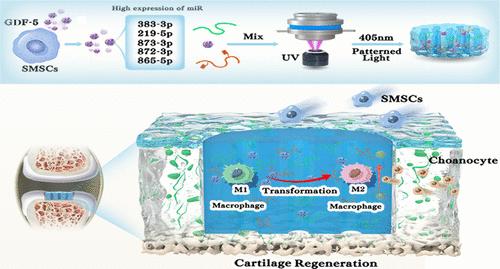生长分化因子5-预处理间充质干细胞衍生外泌体的三维生物打印促进关节软骨内源性再生
IF 16
1区 材料科学
Q1 CHEMISTRY, MULTIDISCIPLINARY
引用次数: 0
摘要
关节软骨缺损的修复仍然是一个重要的再生和临床挑战。间充质干细胞衍生的外泌体(Exos)在软骨组织工程中具有良好的应用潜力。大量研究表明,适当的预处理方法可以促进Exos的治疗效果。生长分化因子5 (GDF-5)在软骨形成和再生中起关键作用。本研究利用GDF-5预处理滑膜间充质干细胞(SMSCs),增强Exos (G-Exos)的促软骨作用。此外,我们证明富含miR-383-3p的G-Exos通过激活Kdm2a/SOX2信号通路增加了SMSCs的成软骨潜能。在此基础上,通过数字光处理(DLP)生物打印将G-Exos加载到甘草酸/甲基丙烯酸酯酰化透明质酸(GA/HA/G-Exos)支架中,以保持生物活性和缓释。GA/HA/G-Exos支架不仅在体外表现出显著的生物学特性,而且显著促进了Sprague-Dawley大鼠关节腔再生微环境的重塑和关节软骨的再生。本研究为利用工程外功能生物支架修复软骨缺损提供了一种有前途的无细胞再生策略。本文章由计算机程序翻译,如有差异,请以英文原文为准。

Three-Dimensional Bioprinting of Growth Differentiation Factor 5-Preconditioned Mesenchymal Stem Cell-Derived Exosomes Facilitates Articular Cartilage Endogenous Regeneration
The repair of articular cartilage defects remains a major regenerative and clinical challenge. Exosomes (Exos) derived from mesenchymal stem cells (MSCs) have good application potential in cartilage tissue engineering. Numerous studies have indicated that appropriate preconditioning methods can promote the therapeutic effect of Exos. Growth differentiation factor 5 (GDF-5) plays a critical role in chondrogenesis and regeneration. In this study, GDF-5 was used to precondition synovial mesenchymal stem cells (SMSCs) to increase the chondrogenic-promoting effect of Exos (G-Exos). In addition, we demonstrated that G-Exos rich in miR-383-3p increased the chondrogenic potential of SMSCs by activating the Kdm2a/SOX2 signaling pathway. On this basis, G-Exos were loaded into a glycyrrhizic acid/methacrylate-acylated hyaluronic acid (GA/HA/G-Exos) scaffold via digital light processing (DLP) bioprinting to maintain bioactivity and sustained release. The GA/HA/G-Exos scaffolds not only presented significant biological properties in vitro but also significantly promoted the remodeling of the joint cavity regenerative microenvironment and the regeneration of articular cartilage in Sprague–Dawley rats. This study provides a promising cell-free regenerative strategy for cartilage defect repair via the use of engineered exofunctionalized biological scaffolds.
求助全文
通过发布文献求助,成功后即可免费获取论文全文。
去求助
来源期刊

ACS Nano
工程技术-材料科学:综合
CiteScore
26.00
自引率
4.10%
发文量
1627
审稿时长
1.7 months
期刊介绍:
ACS Nano, published monthly, serves as an international forum for comprehensive articles on nanoscience and nanotechnology research at the intersections of chemistry, biology, materials science, physics, and engineering. The journal fosters communication among scientists in these communities, facilitating collaboration, new research opportunities, and advancements through discoveries. ACS Nano covers synthesis, assembly, characterization, theory, and simulation of nanostructures, nanobiotechnology, nanofabrication, methods and tools for nanoscience and nanotechnology, and self- and directed-assembly. Alongside original research articles, it offers thorough reviews, perspectives on cutting-edge research, and discussions envisioning the future of nanoscience and nanotechnology.
 求助内容:
求助内容: 应助结果提醒方式:
应助结果提醒方式:


